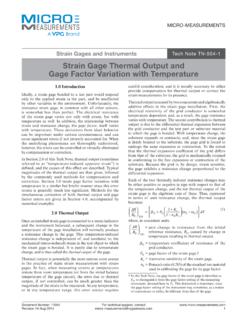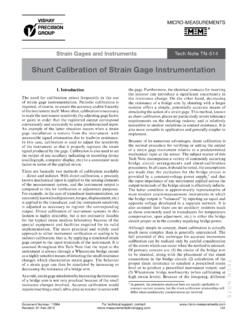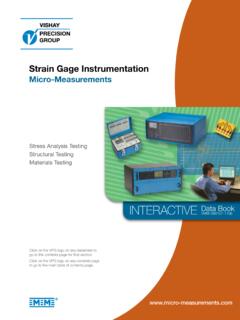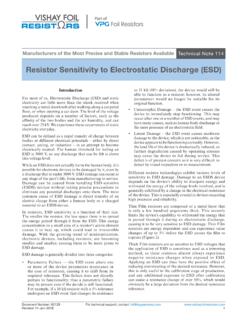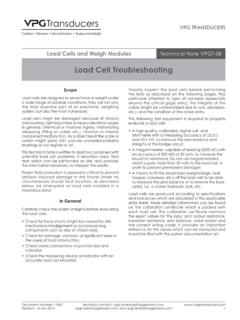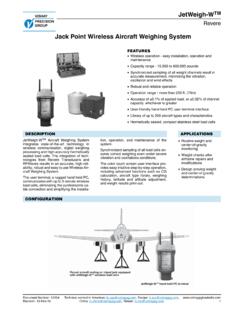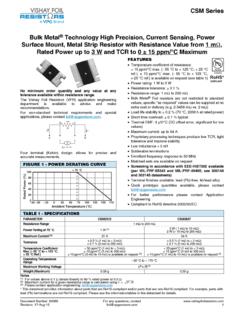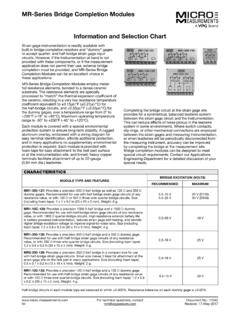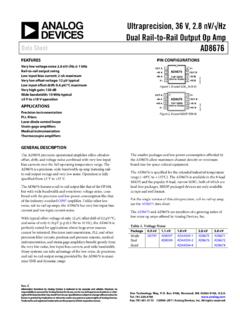Transcription of Strain Gage Selection: Criteria, Procedures, ecommendations
1 Tech Note TN-505-6 Strain gage selection : criteria , procedures , RecommendationsStrain Gages and InstrumentsMICRO-MEASUREMENTSFor technical support, contact Number: 11055 Revision IntroductionThe initial step in preparing for any Strain gage installation is the selection of the appropriate gage for the task. It might at first appear that gage selection is a simple exercise, of no great consequence to the stress analyst; but quite the opposite is true. Careful, rational selection of gage characteristics and parameters can be very important in: optimizing the gage performance for specified environmental and operating conditions, obtaining accurate and reliable Strain measurements, contributing to the ease of installation, and minimizing the total cost of the gage installation and operating characteristics of a Strain gage are affected by the following parameters, which are selectable in varying degrees.
2 Strain -sensitive alloy backing material (carrier) grid resistance gage pattern self-temperature compensation number gage length optionsBasically, the gage selection process consists of determining the particular available combination of parameters which is most compatible with the environmental and other operating conditions, and at the same time best satisfies the installation and operating constraints. These constraints are generally expressed in the form of requirements such as: accuracy test duration stability cyclic endurance temperature ease of installation elongation environmentThe cost of the Strain gage itself is not ordinarily a prime consideration in gage selection , since the significant economic measure is the total cost of the complete installation, of which the gage cost is usually but a small fraction.
3 In many cases, the selection of a gage series or optional feature which increases the gage cost serves to decrease the total installation must be appreciated that the process of gage selection generally involves compromises. This is because parameter choices which tend to satisfy one of the constraints or requirements may work against satisfying others. For example, in the case of a small-radius fillet, where the space available for gage installation is very limited, and the Strain gradient extremely high, one of the shortest available gages might be the obvious choice. At the same time, however, gages shorter than about in (3 mm) are generally characterized by lower maximum elongation, reduced fatigue life, less stable behavior, and greater installation difficulty.
4 Another situation which often influences gage selection , and leads to compromise, is the stock of gages at hand for day-to-day Strain measurements. While compromises are almost always necessary, the stress analyst should be fully aware of the effects of such compromises on meeting the requirements of the gage installation. This understanding is necessary to make the best overall compromise for any particular set of circumstances, and to judge the effects of that compromise on the accuracy and validity of the test Strain gage selection criteria considered here relate primarily to stress analysis applications. The selection criteria for Strain gages used on transducer spring elements, while similar in many respects to the considerations presented here, may vary significantly from application to application and should be treated accordingly.
5 The Micro-Measurements Applications Engineering Department can assist in this gage selection Parameters Strain -Sensing AlloysThe principal component which determines the operating characteristics of a Strain gage is the Strain -sensitive alloy used in the foil grid. How ever, the alloy is not in every case an independently selectable parameter. This is because each Micro-Measurements Strain gage series (identified by the first two, or three, letters in the alphanumeric gage designation) is designed as a complete system. That system is comprised of a particular foil and backing combination, and usually incorporates additional gage construction features (such as encapsulation, integral leadwires, or solder dots) specific to the series in supplies a variety of Strain gage alloys as follows (with their respective letter designations): Strain gage selection : criteria , procedures , RecommendationsFor technical questions, Number: 11055 Revision: Note TN-505-6A: Constantan in self-temperature-compensated : Annealed : : Nickel-chromium alloy, a modified Karma in self-temperature-compensated Constantan AlloyOf all modern Strain gage alloys, constantan is the oldest, and still the most widely used.
6 This situation reflects the fact that constantan has the best overall combination of properties needed for many Strain gage applications. This alloy has, for example, an adequately high Strain sensitivity, or gage factor, which is relatively insensitive to Strain level and temperature. Its resistivity is high enough to achieve suitable resistance values in even very small grids, and its temperature coefficient of resistance is not excessive. In addition, constantan is characterized by good fatigue life and relatively high elongation capability. It must be noted, however, that constantan tends to exhibit a continuous drift at temperatures above +150 F (+65 C); and this characteristic should be taken into account when zero stability of the Strain gage is critical over a period of hours or importantly, constantan can be processed for self- temperature-compensation (see box at right) to match a wide range of test material expansion coefficients.
7 A alloy is supplied in self-temperature-compensation (S-T-C) numbers 00, 03, 05, 06, 09, 13, 15, 18, 30, 40 and 50, for use on test materials with corresponding thermal expansion coefficients (expressed in ppm/ F).For the measurement of very large strains, 5% (50 000 ) or above, annealed constantan (P alloy) is the grid material normally selected. Constantan in this form is very ductile; and, in gage lengths of in (3 mm) and longer, can be strained to >20%. It should be borne in mind, however, that under high cyclic strains the P alloy will exhibit some permanent resistance change with each cycle, and cause a corresponding zero shift in the Strain gage . Because of this characteristic, and the tendency for premature grid failure with repeated straining, P alloy is not ordinarily recommended for cyclic Strain applications.
8 P alloy is available with S-T-C numbers of 08 and 40 for use on metals and plastics, Isoelastic AlloyWhen purely dynamic Strain measurements are to be made that is, when it is not necessary to maintain a stable reference zero isoelastic (D alloy) offers certain advantages. Principal among these are superior fatigue life, compared to A alloy, and a high gage factor (approximately ) which improves the signal-to-noise ratio in dynamic alloy is not subject to self-temperature-compensation. More over, as shown in the graph (see box), its thermal output is so high (about 80 / F (145 / C) that this alloy is not normally usable for static Strain measurements. There are times, however, when D alloy finds application in special-purpose transducers where a high output is needed, and where a full-bridge arrangement can be used to achieve reasonable temperature compensation within the circuit.)
9 Self-Temperature-CompensationAn important property shared by constantan and modified Karma Strain gage alloys is their responsiveness to special processing for self-temperature-compensation. Self-temperature-compensated Strain gages are designed to produce minimum thermal output (temperature-induced apparent Strain ) over the temperature range from about 50 to +400 F ( 45 to +200 C). When selecting either constantan (A-alloy) or modified Karma (K-alloy) Strain gages, the self-temperature-compensation (S-T-C) number must be specified. The S-T-C number is the approximate thermal expansion coefficient in ppm/ F of the structural material on which the Strain gage will display minimum thermal accompanying graph illustrates typical thermal output characteristics for A and K alloys.
10 The thermal output of uncompensated isoelastic alloy is included in the same graph for comparison purposes. In normal practice, the S-T-C number for an A- or K-alloy gage is selected to most closely match the thermal expansion coefficient of the test material. However, the thermal output curves for these alloys can be rotated about the room-temperature reference point to favor a particular temperature range. This is done by intentionally mismatching the S-T-C number and the expansion coefficient in the appropriate direction. When the selected S-T-C number is lower than the expansion coefficient, the curve is rotated counterclockwise. An opposite mismatch produces clockwise rotation of the thermal output curve. Under conditions of S-T-C mismatch, the thermal output curves for A and K alloys do not apply, of course, and it will generally be necessary to calibrate the installation for thermal output as a function of additional information on Strain gage temperature effects, see Tech Note gage selection : criteria , procedures , RecommendationsFor technical questions, Number: 11055 Revision: Note TN-505-6 Other properties of D alloy should also be noted when considering the selection of this grid material.
